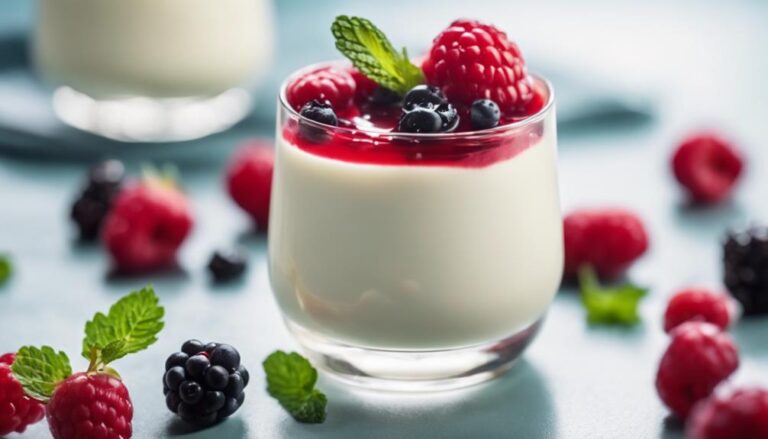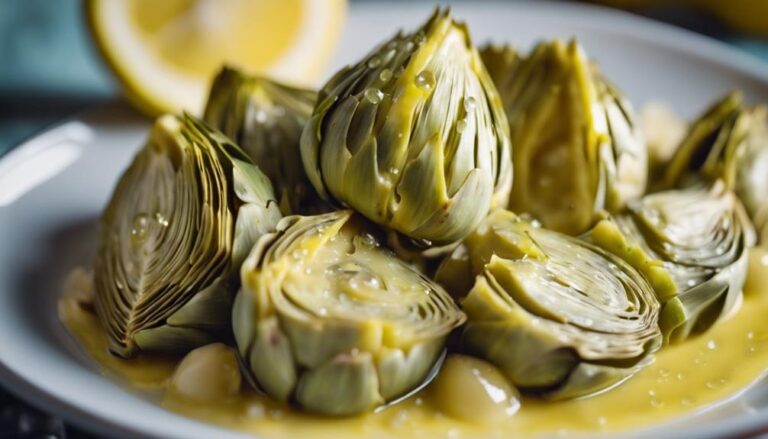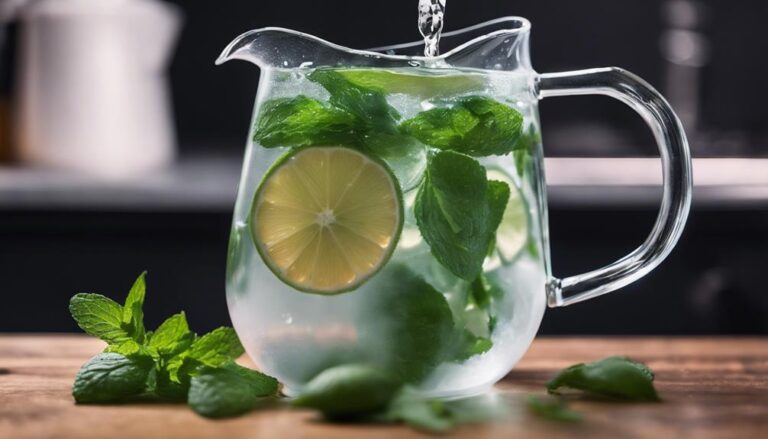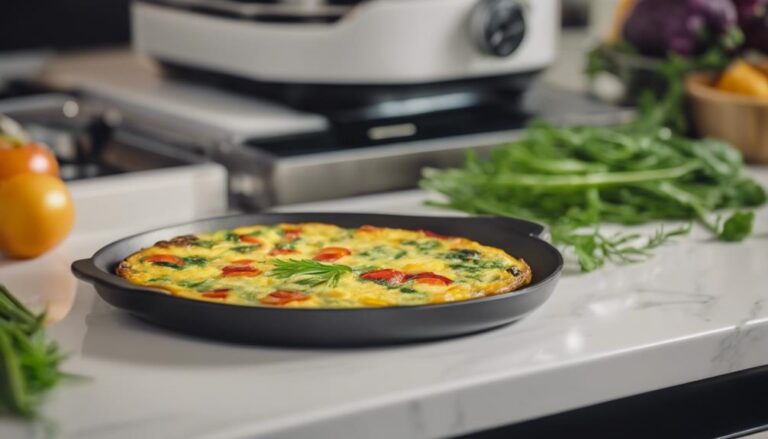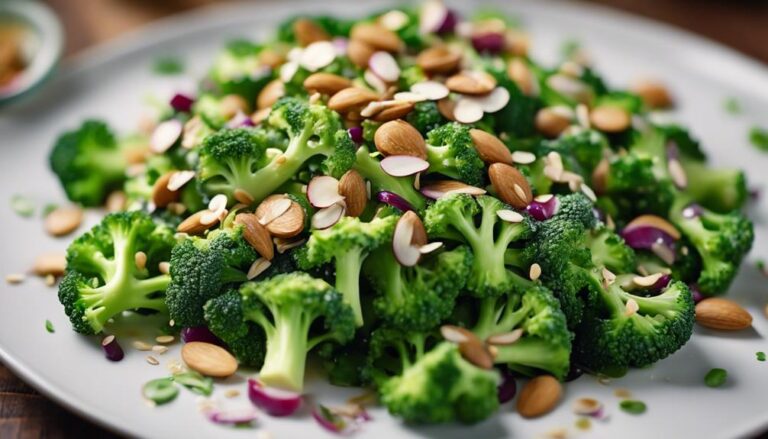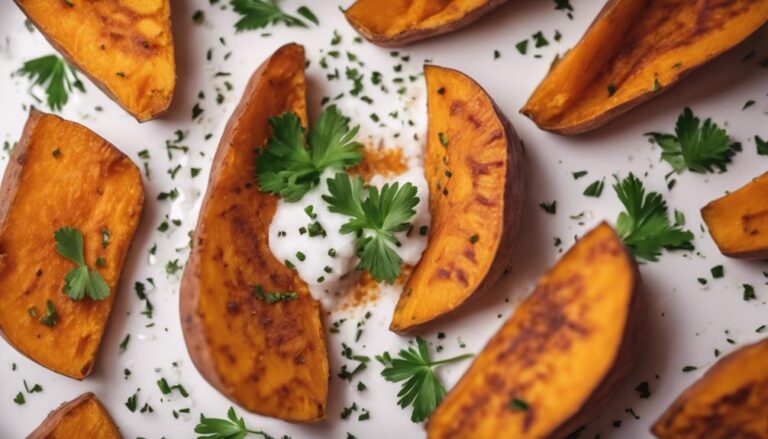Sous Vide Ratatouille With Locally Grown Vegetables
Enjoy sous vide ratatouille with a modern touch using locally grown veggies. Savor the medley of flavors from tomatoes, zucchini, eggplant, bell peppers, and onions, highlighting their freshness. Try precise temperatures for root veggies at 185°F, zucchini and eggplant at 165°F, and tomatoes and bell peppers at 140°F for peak taste. Control temperatures for vibrant colors and nutrient retention. Experiment with combinations to refine your skills and enhance your dish. Explore the fusion of traditional roots with a contemporary twist, elevating your culinary experience with each bite.
What You Will Learn Here
- Sous vide cooking preserves nutrients in locally sourced vegetables.
- Different temperatures suit various vegetables: 185°F for root veggies, 165°F for zucchini/eggplant, and 140°F for tomatoes/peppers.
- Consistent temperature control retains vibrant colors and flavors.
- Experiment with time and temperature for desired textures and flavors.
- Elevate cooking skills by exploring diverse ingredient combinations.
Origins of Ratatouille Dish
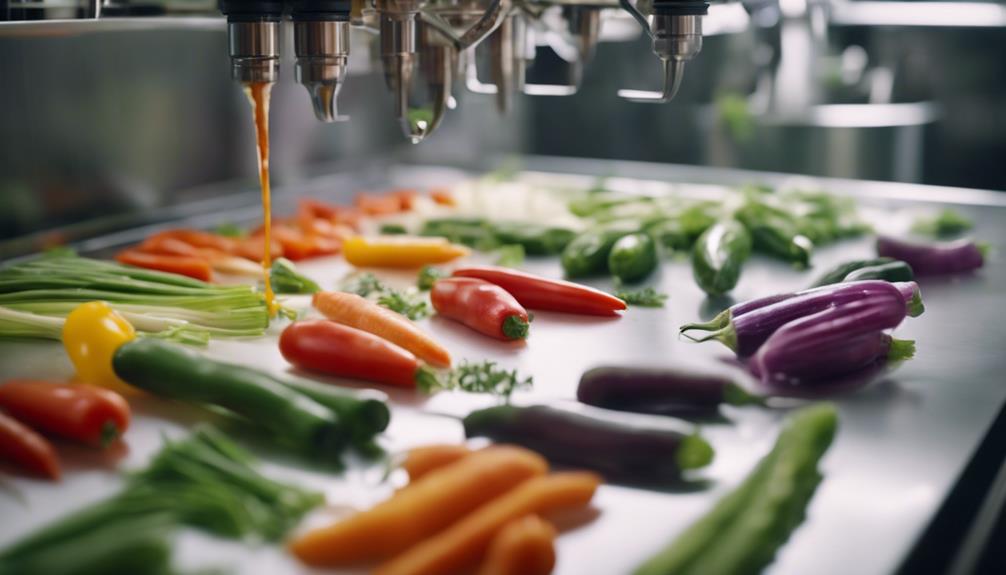
Ratatouille, a classic French dish, traces its origins back to the sunny region of Provence.
The traditional ingredients of tomatoes, zucchini, eggplant, bell peppers, and onions come together to create a harmonious medley of flavors.
Over time, the recipe has evolved to include various interpretations and modern twists while staying true to its rustic roots.
Ratatouille's French Roots
Originating in the Provence region of France, the traditional ratatouille dish boasts a rich history intertwining flavors and techniques from Mediterranean cuisine. Ratatouille is a classic French vegetable stew that showcases the vibrant colors and bold flavors of the region. The dish typically includes a mix of seasonal vegetables such as tomatoes, zucchini, eggplant, bell peppers, and onions, all simmered together with aromatic herbs like thyme, basil, and oregano. This harmonious blend creates a robust and savory flavor profile that is both comforting and satisfying. Ratatouille's French roots are deeply embedded in the culinary traditions of Provence, where fresh produce and simple cooking methods are celebrated. Below is a table highlighting the key aspects of ratatouille's French roots:
| Aspects | Description |
|---|---|
| Region | Provence, France |
| Main Ingredients | Tomatoes, zucchini, eggplant, bell peppers, onions |
| Herbs | Thyme, basil, oregano |
| Cooking Technique | Simmering |
| Culinary Influence | Mediterranean flavors |
Traditional Ingredients Used
Featuring a medley of locally sourced vegetables, the traditional ratatouille dish embodies the essence of Mediterranean flavors and culinary heritage. This classic French dish typically includes tomatoes, zucchini, eggplant, bell peppers, onions, and garlic.
Each ingredient is carefully selected during peak harvest seasons to guarantee the freshest flavors. The traditional cooking techniques involve slow-cooking the vegetables together, allowing their natural juices to meld and intensify, creating a rich and hearty stew-like consistency.
The use of seasonal produce not only enhances the dish's taste but also promotes sustainability and supports local farmers. By honoring these traditional ingredients and cooking methods, ratatouille preserves the authenticity and time-honored traditions of Mediterranean cuisine, making it a beloved and timeless dish.
Evolution of the Recipe
With its roots deeply intertwined in the rustic kitchens of Provence, the evolution of the ratatouille recipe traces back through centuries of culinary craftsmanship and regional influences.
This traditional dish has undergone a fascinating evolution of technique, adapting to modern culinary practices while still honoring its heritage. Initially a humble peasant dish, ratatouille has transformed into a gourmet delight, with chefs experimenting with new cooking methods to enhance flavors and textures.
The integration of local produce has played a pivotal role in this evolution, with chefs now focusing on sourcing the freshest, seasonal vegetables to elevate the dish's taste profile.
Key Ratatouille Ingredients
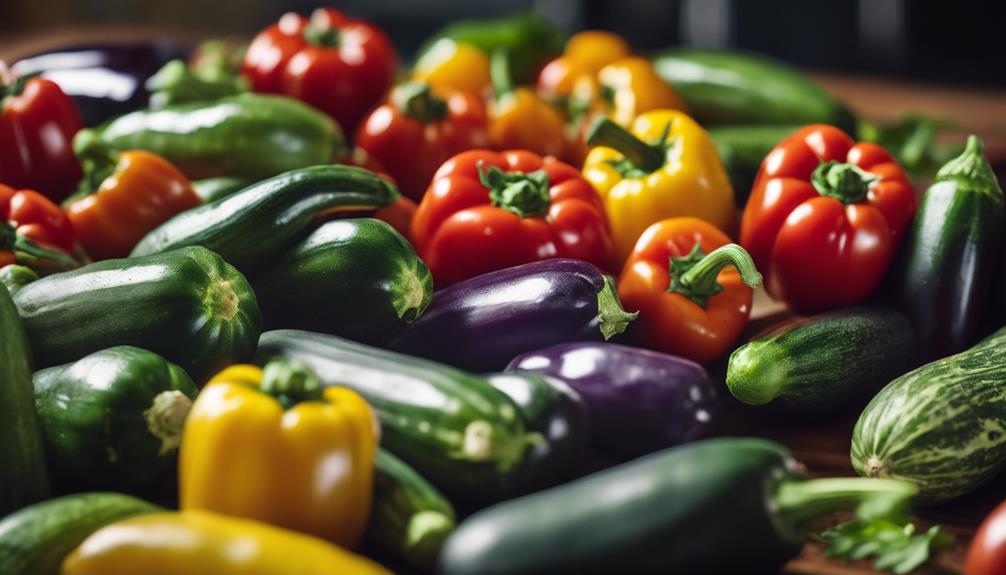
Selecting the freshest and most vibrant vegetables is essential for creating an outstanding ratatouille dish. When it comes to making a traditional ratatouille with a modern twist, the quality of ingredients plays a vital role. Here are some key ingredients to elevate your ratatouille to new heights:
- Eggplant: Look for firm, glossy-skinned eggplants to add a meaty texture and rich flavor to your dish.
- Zucchini: Opt for small to medium-sized zucchinis that are tender and have a vibrant green color for a delicate taste.
- Bell Peppers: Choose ripe, colorful bell peppers such as red, yellow, or orange to bring sweetness and a pop of color to your ratatouille.
- Tomatoes: Use ripe, juicy tomatoes, preferably heirloom varieties, to enhance the sauce's depth and freshness.
- Herbs: Fresh herbs like basil, thyme, and parsley are essential for adding aromatic complexity to your ratatouille.
Sous Vide Ratatouille Variations
Discover the world of farm-fresh flavors with a Sous Vide Ratatouille packed with locally grown vegetables.
Elevate your culinary experience by trying out a savory Eggplant Ratatouille recipe that promises to tantalize your taste buds.
For a burst of vibrant colors and rich flavors, explore the universe of Heirloom Tomato Ratatouille recipes.
Farm-Fresh Ratatouille Sous Vide
For a vibrant twist on traditional ratatouille, consider infusing your locally grown vegetables with sous vide cooking techniques, enhancing their natural flavors and textures. When preparing a farm-fresh ratatouille sous vide, the process allows the vegetables to maintain their nutrients and intensifies their taste. Here are five tips to elevate your ratatouille game:
- Precise Temperature Control: Sous vide guarantees each vegetable is perfectly cooked to preserve its freshness.
- Enhanced Flavor Infusion: The vacuum-sealed bags lock in the flavors, resulting in a more intense taste.
- Uniform Texture: Every bite offers a consistent and tender texture across all vegetables.
- Minimal Nutrient Loss: By cooking in a sealed bag, essential nutrients are retained.
- Customizable Seasonings: Experiment with different herbs and seasonings to tailor the dish to your preferences.
Savory Eggplant Ratatouille Recipe
To enhance the rich flavors of your ratatouille, consider incorporating the earthy essence of eggplant into your sous vide cooking repertoire. Eggplant adds a luxurious depth to the dish, melding beautifully with the other seasonal vegetables.
Here are some tips to elevate your savory eggplant ratatouille:
- Experiment with different varieties of eggplant to find the one that suits your taste best.
- Layer thinly sliced eggplant between other vegetables for a stunning presentation.
- Add a sprinkle of fresh herbs like basil or thyme for a burst of aroma.
- Try serving your ratatouille over creamy polenta for a delightful textural contrast.
- Explore unique flavorful toppings such as toasted pine nuts or crumbled feta cheese for an extra touch of decadence.
These suggestions will surely impress your taste buds and elevate your sous vide cooking experience.
Heirloom Tomato Ratatouille Recipe
Enhance your sous vide culinary repertoire with a vibrant twist by infusing the robust flavors of heirloom tomatoes into your ratatouille recipe. Heirloom tomatoes, with their unique colors and tastes, add a delightful depth to the classic ratatouille dish. Embrace the essence of summer harvest with this innovative variation that will elevate your cooking game to new heights. Let the culinary creativity flow as you experiment with this Heirloom Tomato Ratatouille Recipe.
- Sun-Kissed Flavors: Enjoy the rich, sweet taste of sun-ripened heirloom tomatoes.
- Colorful Medley: Create a visually stunning dish with a variety of heirloom tomato hues.
- Enhanced Aromas: Elevate the aroma of your ratatouille with the distinctive scent of heirloom tomatoes.
- Complex Taste Profile: Experience a more nuanced flavor profile with the diverse heirloom tomato selection.
- Textural Contrast: Add a delightful texture contrast to your ratatouille with the different textures of heirloom tomatoes.
Sous Vide Temperature Control
Maintaining precise temperature settings in sous vide cooking is essential for achieving consistent and reliable results. The correlation between time and temperature plays a significant role in determining the final texture and doneness of your dish.
Understanding these nuances is necessary for mastering the art of sous vide cooking and elevating your culinary creations to the next level.
Precise Temperature Settings
For ideal sous vide cooking results, precision in temperature control is essential. When setting your sous vide machine, consider the cooking techniques and benefits of sous vide. Maintaining accurate temperature throughout the cooking process is vital for achieving the desired texture and flavor retention in your ratatouille.
| Temperature Setting | Description |
|---|---|
| 185°F | Ideal for root vegetables like carrots and potatoes, ensuring they become tender without losing their natural sweetness. |
| 165°F | Perfect for zucchini and eggplant, preserving their delicate textures while infusing them with flavorful herbs and spices. |
| 140°F | Ideal for tomatoes and bell peppers, allowing them to retain their freshness and vibrant taste without overcooking. |
Consistent Cooking Results
Achieving consistent cooking results in sous vide relies heavily on precise temperature control throughout the cooking process.
Sous vide techniques offer a range of benefits, such as ensuring that your locally sourced produce retains its freshness and flavor profiles.
By maintaining a constant temperature in the water bath, you allow the vegetables from your garden or nearby farm to cook evenly and thoroughly without losing their nutrients and vibrant colors.
The controlled environment of sous vide cooking guarantees that each vegetable piece receives equal heat distribution, resulting in a perfectly cooked ratatouille every time.
This method not only enhances the taste of your dish but also showcases the quality of the ingredients, highlighting the essence of locally grown produce in a delightful and consistent manner.
Time and Temperature Correlation
Ensuring precise time and temperature correlation is essential for mastering sous vide temperature control. Temperature accuracy is paramount in sous vide cooking, as even a slight variation can greatly impact the final dish.
To achieve consistent and delicious results, it's vital to pay close attention to the cooking time optimization. Different vegetables and ingredients require specific temperatures and times to reach the desired texture and flavor profile.
By understanding the relationship between time and temperature, you can discover a world of culinary possibilities with sous vide cooking. Experimenting with different combinations and adjusting these variables will help you perfect your dishes and elevate your cooking skills to new heights.
Final Thoughts
In reflecting on the culinary journey of creating this sous vide ratatouille with locally grown vegetables, one can't help but appreciate the harmonious blend of flavors and textures that elevate this classic dish to a new level of gastronomic delight. The use of local produce not only enhances the sustainability of the dish but also guarantees the freshest ingredients are incorporated, adding depth and vibrancy to each bite. By employing the flavor infusion technique of sous vide cooking, the vegetables retain their natural essence while absorbing the herbaceous notes and spices, resulting in a symphony of tastes that dance on your palate.
The final product is a demonstration of the innovative possibilities that lie within traditional recipes when approached with creativity and precision. The tender yet distinct textures of the vegetables, the rich umami flavors that linger on your taste buds, and the visually appealing presentation all speak to the meticulous care and attention given to each component. This sous vide ratatouille serves as a reminder that culinary excellence can be achieved through a thoughtful balance of technique, ingredients, and passion for the craft.
Frequently Asked Questions
Can I Use Frozen Vegetables for Sous Vide Ratatouille?
You can use frozen vegetables for your sous vide ratatouille, but fresh ones generally provide better flavor and texture. Add flavor enhancements like herbs and spices to elevate the dish. Experiment with both options to find your perfect balance.
How Can I Adjust the Recipe for a Spicier Ratatouille?
To spice up your ratatouille, add chili flakes or hot sauce for a fiery kick. Incorporate spicy eggplant or jalapeno peppers for extra heat and depth of flavor. Experiment with different levels of spiciness to suit your taste.
Is It Safe to Reuse the Sous Vide Bags for Vegetables?
Prioritizing safety is crucial when considering sous vide bag reuse. Sustainability is commendable, but prioritize cleanliness and proper storage to prevent contamination. Be critical and innovative in maintaining bag hygiene for vegetable sous vide.
Can I Prepare Ratatouille in Advance and Reheat It?
Yes, you can prepare ratatouille in advance for convenience. To enhance flavors, consider slow-cooking or sous vide methods. Store in airtight containers in the fridge for up to 4 days or freeze for longer. Reheat gently on stovetop or microwave.
What Are Some Creative Ways to Serve Sous Vide Ratatouille?
For a stunning presentation, consider layering the ratatouille in a ring mold before serving. Drizzle with a balsamic reduction and sprinkle fresh herbs. Season with sea salt and cracked black pepper. Enjoy the vibrant flavors!
Conclusion
Indulge in the flavors of summer with a perfectly cooked sous vide ratatouille, made with locally sourced vegetables for a fresh and vibrant twist on a classic dish.
The precise temperature control of sous vide cooking guarantees each ingredient retains its individual taste and texture, resulting in a harmonious blend of flavors in every bite.
Elevate your culinary skills and impress your guests with this delicious and visually stunning dish.
Bon appétit!






